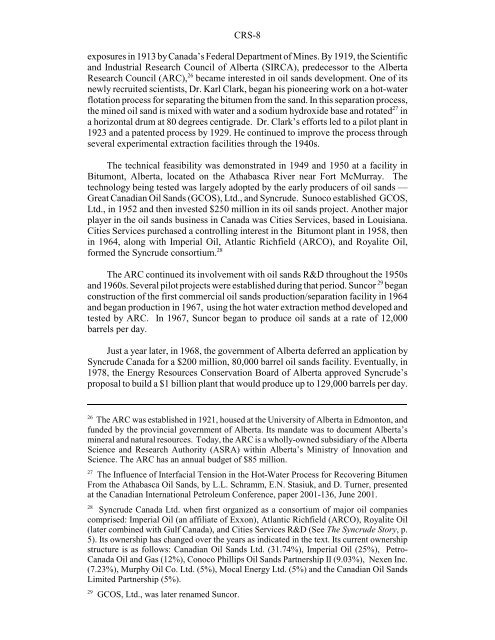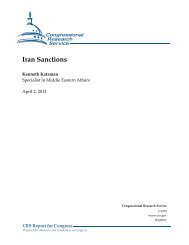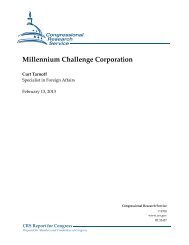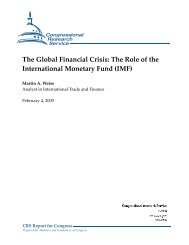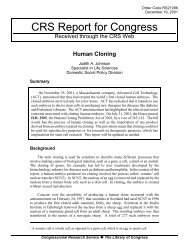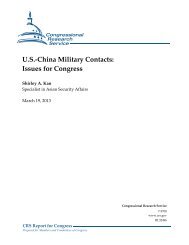North American Oil Sands: History of ... - The Air University
North American Oil Sands: History of ... - The Air University
North American Oil Sands: History of ... - The Air University
Create successful ePaper yourself
Turn your PDF publications into a flip-book with our unique Google optimized e-Paper software.
CRS-8<br />
exposures in 1913 by Canada’s Federal Department <strong>of</strong> Mines. By 1919, the Scientific<br />
and Industrial Research Council <strong>of</strong> Alberta (SIRCA), predecessor to the Alberta<br />
Research Council (ARC), 26 became interested in oil sands development. One <strong>of</strong> its<br />
newly recruited scientists, Dr. Karl Clark, began his pioneering work on a hot-water<br />
flotation process for separating the bitumen from the sand. In this separation process,<br />
the mined oil sand is mixed with water and a sodium hydroxide base and rotated 27 in<br />
a horizontal drum at 80 degrees centigrade. Dr. Clark’s efforts led to a pilot plant in<br />
1923 and a patented process by 1929. He continued to improve the process through<br />
several experimental extraction facilities through the 1940s.<br />
<strong>The</strong> technical feasibility was demonstrated in 1949 and 1950 at a facility in<br />
Bitumont, Alberta, located on the Athabasca River near Fort McMurray. <strong>The</strong><br />
technology being tested was largely adopted by the early producers <strong>of</strong> oil sands —<br />
Great Canadian <strong>Oil</strong> <strong>Sands</strong> (GCOS), Ltd., and Syncrude. Sunoco established GCOS,<br />
Ltd., in 1952 and then invested $250 million in its oil sands project. Another major<br />
player in the oil sands business in Canada was Cities Services, based in Louisiana.<br />
Cities Services purchased a controlling interest in the Bitumont plant in 1958, then<br />
in 1964, along with Imperial <strong>Oil</strong>, Atlantic Richfield (ARCO), and Royalite <strong>Oil</strong>,<br />
formed the Syncrude consortium. 28<br />
<strong>The</strong> ARC continued its involvement with oil sands R&D throughout the 1950s<br />
and 1960s. Several pilot projects were established during that period. Suncor 29 began<br />
construction <strong>of</strong> the first commercial oil sands production/separation facility in 1964<br />
and began production in 1967, using the hot water extraction method developed and<br />
tested by ARC. In 1967, Suncor began to produce oil sands at a rate <strong>of</strong> 12,000<br />
barrels per day.<br />
Just a year later, in 1968, the government <strong>of</strong> Alberta deferred an application by<br />
Syncrude Canada for a $200 million, 80,000 barrel oil sands facility. Eventually, in<br />
1978, the Energy Resources Conservation Board <strong>of</strong> Alberta approved Syncrude’s<br />
proposal to build a $1 billion plant that would produce up to 129,000 barrels per day.<br />
26 <strong>The</strong> ARC was established in 1921, housed at the <strong>University</strong> <strong>of</strong> Alberta in Edmonton, and<br />
funded by the provincial government <strong>of</strong> Alberta. Its mandate was to document Alberta’s<br />
mineral and natural resources. Today, the ARC is a wholly-owned subsidiary <strong>of</strong> the Alberta<br />
Science and Research Authority (ASRA) within Alberta’s Ministry <strong>of</strong> Innovation and<br />
Science. <strong>The</strong> ARC has an annual budget <strong>of</strong> $85 million.<br />
27 <strong>The</strong> Influence <strong>of</strong> Interfacial Tension in the Hot-Water Process for Recovering Bitumen<br />
From the Athabasca <strong>Oil</strong> <strong>Sands</strong>, by L.L. Schramm, E.N. Stasiuk, and D. Turner, presented<br />
at the Canadian International Petroleum Conference, paper 2001-136, June 2001.<br />
28 Syncrude Canada Ltd. when first organized as a consortium <strong>of</strong> major oil companies<br />
comprised: Imperial <strong>Oil</strong> (an affiliate <strong>of</strong> Exxon), Atlantic Richfield (ARCO), Royalite <strong>Oil</strong><br />
(later combined with Gulf Canada), and Cities Services R&D (See <strong>The</strong> Syncrude Story, p.<br />
5). Its ownership has changed over the years as indicated in the text. Its current ownership<br />
structure is as follows: Canadian <strong>Oil</strong> <strong>Sands</strong> Ltd. (31.74%), Imperial <strong>Oil</strong> (25%), Petro-<br />
Canada <strong>Oil</strong> and Gas (12%), Conoco Phillips <strong>Oil</strong> <strong>Sands</strong> Partnership II (9.03%), Nexen Inc.<br />
(7.23%), Murphy <strong>Oil</strong> Co. Ltd. (5%), Mocal Energy Ltd. (5%) and the Canadian <strong>Oil</strong> <strong>Sands</strong><br />
Limited Partnership (5%).<br />
29 GCOS, Ltd., was later renamed Suncor.


